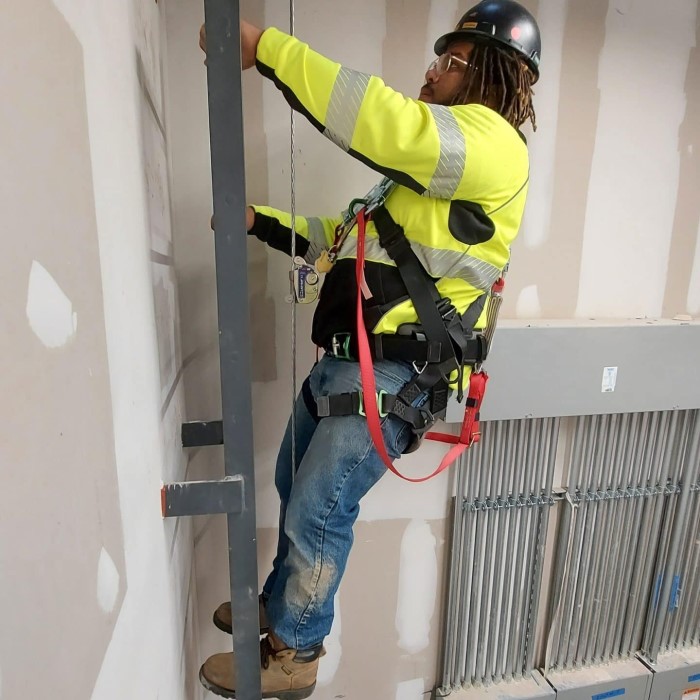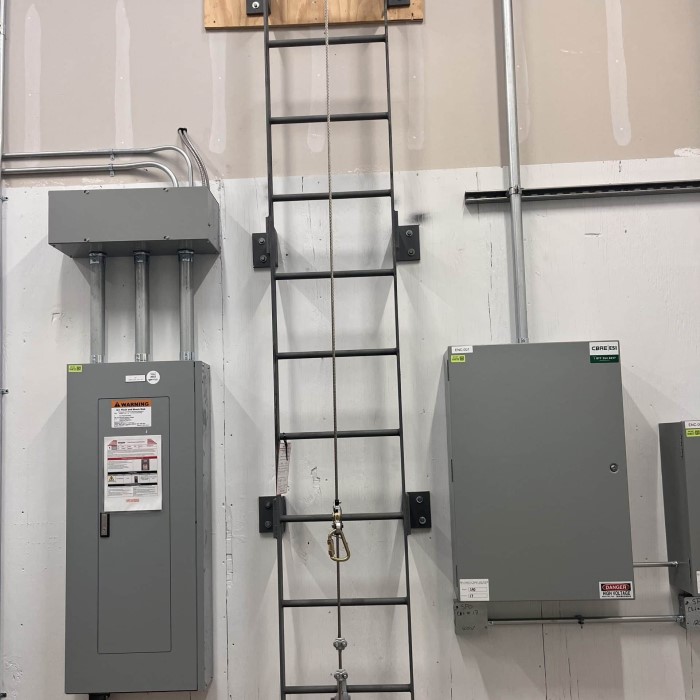Introduction
Ladders are essential for various tasks, but they pose significant safety risks. Proper ladder fall protection ensures safe use and prevents accidents. Understanding its importance and the common incidents that occur is key to improving workplace safety.

Importance of Ladder Safety
Ladder safety is vital to prevent serious injuries and fatalities. Falls from ladders account for a major percentage of workplace accidents. Proper safety measures save lives and improve productivity. Employers and workers must prioritize ladder safety by following clear protocols and using suitable equipment.
Common Types of Ladder Fall Incidents
Many ladder accidents occur due to misuse or neglect. The most common types include:
- Falls due to Overreaching: Extending too far while on a ladder destabilizes its balance.
- Improper Ladder Placement: Uneven or slippery surfaces cause ladders to tip over.
- Climbing with Heavy Loads: Carrying excessive weight disrupts control and stability while ascending or descending.
- Structural Ladder Failure: Using damaged ladders increases the risk of collapse during use.
Understanding these incidents helps in identifying risks and implementing effective preventive measures. Proper training and inspections minimize these hazards.
Regulations and Standards
Ladder fall protection requires adhering to strict regulations and standards. These rules ensure safer usage and reduce risks. Following them minimizes accidents and promotes a safer working environment for all.
OSHA Requirements for Ladder Use
OSHA (Occupational Safety and Health Administration) sets important safety requirements for ladder use. These guidelines focus on:
- Proper Ladder Placement: Ladders must be placed on stable, non-slippery surfaces.
- Using the Right Ladder: Workers should select ladders with the correct height and load capacity.
- Three-Point Contact Rule: Workers must always maintain three points of contact on the ladder.
- Pre-Use Inspections: Ladders should be checked for any damage or wear before use.
- Securing Ladders: All ladders over 24 feet need fall protection measures, like cages or personal fall arrest systems.
Employers must provide training on OSHA-compliant ladder usage. Enforcing these rules can significantly lower accident rates.
ANSI Standards for Fall Protection Equipment
ANSI (American National Standards Institute) creates standards for fall protection equipment. These standards ensure high-quality and reliable safety tools. Key points include:
- Materials and Design: Equipment like harnesses, lanyards, and anchors must meet durability standards.
- Load Capacity: Devices should support the required weight and withstand stress during falls.
- Regular Testing: Fall protection equipment needs regular testing and certification for continued use.
- Inspection Guidelines: Workers must inspect all equipment before and after each use.
Complying with ANSI standards ensures robust fall protection systems that safeguard workers. Familiarizing yourself with these standards enhances workplace safety.
Types of Ladder Fall Protection Systems
Ladder fall protection systems play a crucial role in ensuring worker safety. These systems are designed to reduce the risk of falls and prevent severe injuries. Selecting the right system depends on the ladder type, the task at hand, and specific workplace conditions.
Fixed Ladder Fall Arrest Systems
Fixed ladder fall arrest systems provide permanent safety features for ladders commonly used in industrial settings. Key characteristics of these systems include:
- Vertical Safety Rails: These rails run along the length of the ladder and allow workers to attach themselves securely.
- Ladder Safety Cables: Connected to a body harness, these cables prevent falls and ensure users remain anchored.
- Integrated Fall Arrest Devices: These devices instantly stop a fall in progress, minimizing injury risks.
- Durable Construction: Fixed systems are made from strong materials like stainless steel to ensure reliability.
Fixed systems are ideal for sites with repetitive ladder usage, such as warehouses and manufacturing plants. They require proper installation and periodic inspections to remain effective.
Portable and Temporary Ladder Protection Solutions
Portable and temporary solutions offer flexibility for projects requiring short-term or mobile ladder use. They are particularly useful for construction and maintenance tasks. Key features include:
- Harness Systems with Temporary Anchors: Workers can attach harnesses to portable anchor points, ensuring mobility and safety.
- Adjustable Lifelines: These lifelines are compatible with various ladder heights and locations.
- Freestanding Guardrail Kits: Installed around ladder access points, they protect workers from accidental falls.
- Reusable Equipment: These systems are easy to transport, install, and remove after use.
Portable systems are cost-effective and quick to deploy. However, it is crucial to follow guidelines to ensure proper setup and effectiveness.
Implementing the correct ladder fall protection system builds a safer work environment, reduces accidents, and ensures compliance with safety standards.
Equipment Used
Proper equipment ensures the effectiveness of ladder fall protection systems. Workers must use reliable gear to minimize risks. Understanding the types of equipment helps in selecting the right tools.
Harnesses and Lanyards
Harnesses and lanyards are essential components of ladder fall protection systems. These tools keep workers secure while working at heights.
- Body Harnesses: Full-body harnesses distribute impact forces evenly during falls. They provide maximum comfort and safety.
- Shock-Absorbing Lanyards: These lanyards reduce the impact force felt by workers during a fall.
- Retractable Lifelines: Lifelines adjust automatically and prevent tangling while providing mobility.
- Connection Points: Ensure lanyards and harnesses have strong and reliable anchor connections.
Regular inspection of harnesses and lanyards is crucial. Replace damaged gear immediately to maintain safety.
Guardrails and Safety Nets
Guardrails and safety nets prevent falls directly. They are often used around high-risk ladder areas.
- Freestanding Guardrails: Guardrails keep workers from accidentally stepping off elevated platforms.
- Temporary Safety Nets: Nets catch workers in case of slips or falls.
- Durable Materials: Quality materials ensure guardrails and nets function effectively under stress.
- Adjustable Dimensions: They can be customized to cover various ladder setups.
Proper installation and maintenance of guardrails and safety nets are crucial. These systems protect not just the worker but also those below.
Using the correct equipment reduces accidents and aligns with safety standards. Consistent training on their use ensures maximum effectiveness.
Best Practices
Ladder fall protection requires proper practices to ensure a safe working environment. Following best practices reduces risks, prevents injuries, and ensures compliance with safety standards.
Proper Ladder Setup and Angle
Setting up a ladder correctly is essential for safety. Follow these guidelines for proper setup:
- Stable Surface Placement: Position the ladder on a flat, stable surface to prevent tipping or slipping.
- Correct Angle: Place the ladder at a 4:1 angle; for every 4 feet of height, position 1 foot away from the base.
- Secure the Ladder: Use ladder stabilizers or braces to enhance sturdiness.
- Avoid Over-Extending: Ensure the ladder height matches the required task to prevent overreaching.
- Check Surroundings: Verify the ladder is away from hazards like power lines or unstable structures.
Proper setup and angle improve ladder stability, reduce fall risks, and ensure efficiency during tasks.
Inspecting and Maintaining Ladder Equipment
Regular inspection and maintenance are pivotal for ladder safety. Follow these steps to keep equipment in good condition:
- Pre-Use Inspections: Check for any damage, wear, or structural issues before each use.
- Inspect Ladder Feet: Make sure ladder feet are secure and non-slip to prevent movement.
- Remove Debris: Clean ladders to avoid slipping due to dirt or grease.
- Replace Damaged Parts: Repair or replace worn-out components, such as rungs or locks, immediately.
- Store Properly: Keep ladders in dry and safe areas to prevent deterioration.
Inspecting and maintaining ladders ensure their reliability and reduce accident chances. Consistent care enhances their longevity and effectiveness.
Following these best practices significantly improves ladder safety.
Training and Education for Ladder Safety
Training and education are essential to ensure safe ladder usage. They minimize risks and improve workplace safety. Proper training addresses user behavior, understanding of equipment, and adherence to safety guidelines.
Key Areas of Training for Ladder Users
To reduce ladder-related risks, employers should focus on specific training areas for users:
- Equipment Familiarity: Workers should learn about ladder types and their proper use.
- Usage Techniques: Training should demonstrate safe climbing practices, including the three-point contact rule.
- Hazard Awareness: Educate users on potential hazards like overreaching or unstable ladder placement.
- Inspection Practices: Train employees to inspect ladders before every use for wear or damage.
- Fall Protection Integration: Teach proper use of harnesses, lanyards, and other fall protection equipment.
- Emergency Procedures: Workers must know how to respond in case of ladder accidents or falls.
Regular training ensures safety knowledge remains updated. It builds safer habits and prevents accidents.
Promoting Awareness Through Regular Safety Drills
Safety drills are vital for reinforcing ladder safety practices. They simulate real situations to prepare workers.
- Scenario-Based Drills: Test workers with scenarios involving ladder placement and use at different heights.
- Equipment Identification: Include exercises to choose correct ladder types and fall protection equipment.
- Response Training: Teach immediate response steps for falls or ladder failures during drills.
- Group Sessions: Use group drills to highlight teamwork and mutual support in safety measures.
- Continuous Evaluation: Regular drills help identify knowledge gaps and improve training effectiveness.
Frequent safety drills encourage awareness and build confidence for handling ladder-related tasks. Combining drills with formal training minimizes risks and strengthens workplace safety.
Common Mistakes
Avoiding common mistakes in ladder fall protection can prevent accidents and ensure worker safety. Recognizing these errors helps improve practices, minimize risks, and comply with safety regulations.
Overloading Capacity Limits
Overloading a ladder is a frequent mistake and can lead to dangerous accidents. Here are key points to avoid overloading:
- Follow Ladder Weight Ratings: Always check and adhere to the manufacturer’s weight capacity guidelines.
- Consider Combined Weight: Include your body weight, tools, and materials when evaluating load limits.
- Use the Right Ladder: Select a ladder designed for the task and load requirements.
- Avoid Carrying Heavy Tools: Use tool belts or lift systems instead of carrying excessive weight on the ladder.
Overloading a ladder weakens its structure, increasing the chances of collapse. Stick to these measures to stay safe.
Using Damaged or Improper Equipment
Damaged or unsuitable equipment significantly raises the risk of falls and injuries. Here’s how to avoid this:
- Inspect Before Use: Examine ladders for cracks, bent rungs, or missing parts before each use.
- Avoid DIY Repairs: Do not use ladders with makeshift fixes. Replace damaged equipment promptly.
- Select the Correct Type: Match the ladder type to the specific job requirements.
- Ensure Safety Features: Verify safety features, like non-slip feet or locking mechanisms, are functioning.
Using damaged or improper ladders endangers both workers and bystanders. Conduct regular checks to ensure safety compliance.
By addressing these common mistakes, you significantly reduce risks and promote a safer workplace. Proper training and consistent vigilance can help avoid these errors and keep everyone safe.
Choosing the Right Ladder Fall Protection Solution
Selecting the right ladder fall protection system is vital for ensuring worker safety and compliance. The choice depends on factors like workplace conditions, task requirements, and budget. Understanding these factors enables informed decision-making and better overall safety.
Assessing the Workplace Environment
The workplace environment directly impacts the type of ladder fall protection needed. Consider the following points:
- Ladder Type and Usage: Identify if the work involves fixed, portable, or extension ladders.
- Height and Workload: Evaluate ladder height and weight limits needed for the tasks.
- Specific Hazards: Look for risks like uneven surfaces, nearby power lines, or falling objects.
- Durability Needs: Choose materials suited for environmental factors like moisture, temperature, or chemicals.
- Worker Movement: Decide if mobility is required or if the task takes place in a confined space.
A thorough assessment ensures the chosen protection aligns with workplace realities, reducing risks effectively.
Comparing Costs and Effectiveness
Balancing costs with system effectiveness ensures safety without overspending. Analyze the following aspects:
- Initial Investment: Assess upfront costs for purchasing or installing the protection system.
- Longevity: Evaluate how durable and resistant the system is to wear and tear.
- Ease of Use: Ensure the system is user-friendly to encourage consistent use by workers.
- Maintenance Costs: Consider expenses for system inspections, repairs, and replacements.
- Performance Standards: Verify compliance with OSHA and ANSI safety regulations to avoid penalties.
Evaluate several options to weigh cost against reliability. Choose a solution that protects workers while offering long-term value.
Careful consideration of the work environment and costs ensures the right ladder fall protection system is implemented. This approach minimizes risks and helps maintain a safer workplace.
Conclusion
In conclusion, understanding ladder fall protection is essential for anyone who works at heights. By recognizing the risks, selecting the proper ladders, implementing safe practices, and providing adequate training, we can significantly reduce the chances of accidents and injuries.
As we strive for a safer work environment, let’s prioritize ladder safety and make informed decisions regarding equipment and practices. Remember, your safety and that of your colleagues depend on consistent awareness and commitment to ladder fall protection strategies. By doing so, you ensure that you, and those around you, can work confidently and securely.





